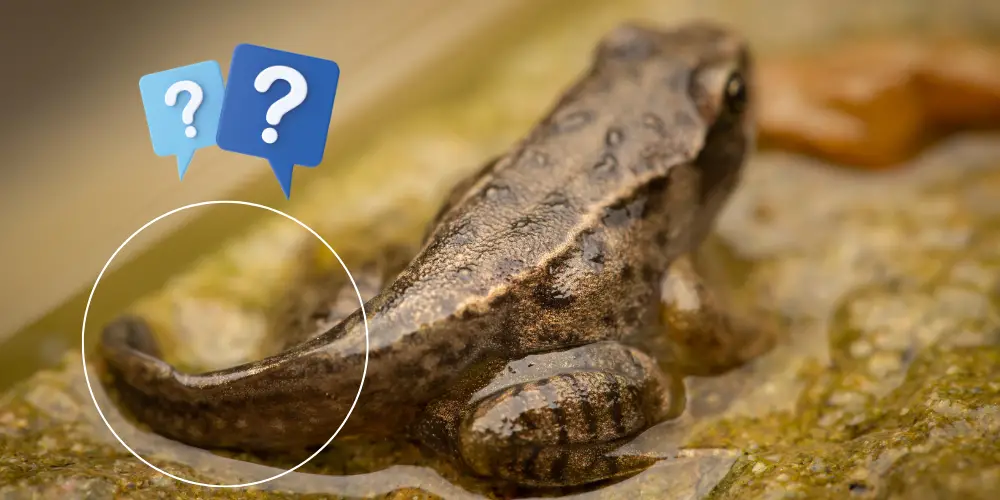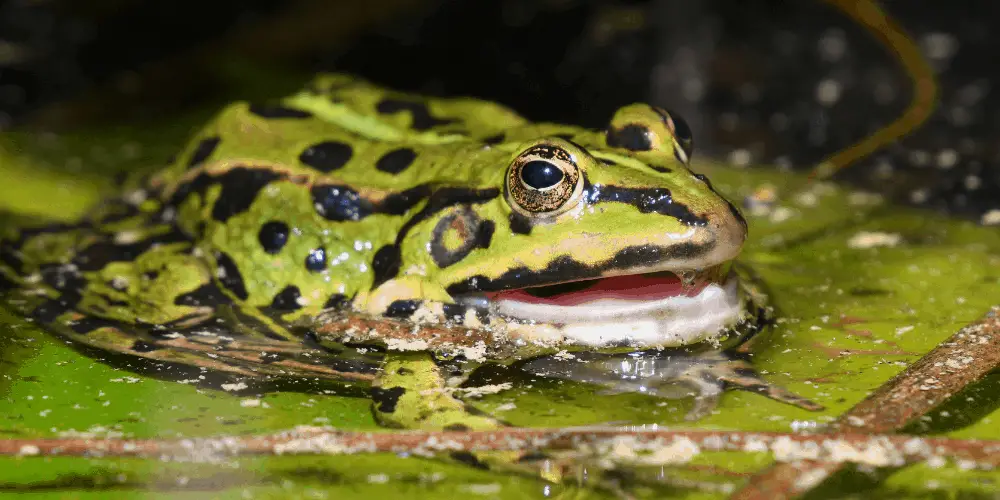“Do Frogs Have Tails?” is a simple question that uncovers a fascinating world of amphibian transformation.
While many of us might instantly think of the hopping, green creatures we see after a rainstorm, the journey of a frog from its early days is quite captivating.
Frogs begin life as tadpoles with tails. These tails are reabsorbed as they mature, resulting in tailless adult frogs. However, two species, the coastal-tailed frog (Ascaphus truei) and the mountain-tailed frog (Ascaphus montanus), keep tail-like extensions unique to males for reproduction.
Stay with us as we leap into this intriguing topic, shedding light on the wonders of frog development and the mysteries behind their missing tails. It’s time for a deep dive into froggy facts!
Key Takeaways
- Frogs transform from gilled, tailed tadpoles to air-breathing, tailless adults.
- Tadpole tails, essential for aquatic navigation, are reabsorbed, providing nutrients during metamorphosis.
- Coastal-tailed frog and mountain-tailed frog males retain tail-like extensions for reproductive purposes.
- The tail-like extensions in certain frog species ensure successful reproduction in fast-moving streams.
- The froglet phase marks a transition, where the amphibian displays both legs and a tail.
- Like the wood frog, some frog species can survive freezing temperatures through suspended animation.
- Frogs can jump up to 20 times their body length, showcasing their athleticism.
- Some frog species can change skin colors for camouflage.
- The Surinam toad embeds its eggs in its back skin, with toads emerging directly from it.
- Newts and salamanders, amphibian relatives of frogs, retain tails throughout their lives.
Frog Development and Tail Presence
Frogs undergo one of the most captivating transformations in the animal kingdom, evolving from gilled, tailed tadpoles to air-breathing, tailless adults. Here’s a step-by-step breakdown of this metamorphosis:
- Tadpole Emergence: In their earliest stages, frogs exist as tadpoles. These aquatic larvae resemble tiny fish, equipped with gills for underwater breathing and a pronounced tail to aid swimming.
- Tail’s Purpose: The tail serves a vital function for the tadpole, providing mobility. Acting as the primary propulsion mechanism, the tadpole can navigate aquatic environments, swiftly darting toward food or away from threats.
- Onset of Leg Development: The transformation begins in earnest when hind legs sprout. These are the tadpole’s first steps towards its eventual frog form.
- Emergence of Forelegs: Soon after the hind legs, the forelegs begin to develop, signaling a shift in mobility from the tail to the legs.
- Respiratory Shift: As the tadpole prepares for terrestrial life, the gills, which are essential for extracting oxygen from water, start to recede. In their place, lungs develop, prepping the creature for breathing.
- Tail Absorption: One of the metamorphosis’s most striking elements is the gradual absorption of the tail. The tadpole reabsorbs the tail’s nutrients, utilizing them to support its rapid transformation. As the tail reduces in size, the legs take over as the primary means of movement.
- Juvenile Frog Stage: With the tail completely absorbed and fully developed legs, the tadpole transitions into its juvenile frog stage, ready to embark on its terrestrial journey.
This step-by-step breakdown showcases frog development’s systematic and resourceful process, illustrating nature’s remarkable ability to adapt and change.
Why Adult Frogs Lack Tails
Understanding why adult frogs don’t have tails involves considering a few key aspects:
- Aquatic Beginnings: In their tadpole stage, frogs are aquatic. The tail acts as a rudder, helping them navigate water effectively.
- Transition to Terrestrial Life: As tadpoles mature and prepare for life on land, their bodies undergo significant changes, preparing them for a different environment.
- Leg Development: Tadpoles develop strong, muscular legs perfect for hopping and leaping on land. These legs become their primary means of locomotion.
- Potential Hindrance of a Tail: A tail could be a hindrance on land. It might obstruct movement or make frogs more noticeable to predators.
- Tail Reabsorption: The tail doesn’t just disappear; it gets reabsorbed. This process provides essential nutrients during the transformation from tadpole to frog, supporting their development.
- Nature’s Design: A frog’s body is designed to be efficient for its environment. A tail-less adult frog is better suited for a terrestrial lifestyle, where its primary challenges and activities differ vastly from its earlier aquatic life.
Building on this understanding of adult frogs and their tailless nature it raises curiosity about how different terminologies define frogs at various life stages.
As we proceed, let’s delve deeper into terms like “froglets” and their significance in the frog life cycle.
Tailed Frogs: Unique Cases
The diverse world of frog species is full of surprises, including the intriguing phenomenon of adult-tailed frogs.
Notably, species like the coastal-tailed frog (Ascaphus truei) and the mountain-tailed frog (Ascaphus montanus) retain what appears to be a “tail” well into their adult stages. However, this feature is primarily seen in males.
Interestingly, these tails are not true tails as we might think of them. Instead, they are extensions of the male’s cloaca, serving a unique reproductive purpose.
Residing in the fast-moving streams of the Pacific Northwest and higher altitudes, respectively, these species have adapted this tail-like extension for the internal fertilization of eggs.
This ensures that the cool waters don’t wash the sperm away, offering a higher chance of successful reproduction.
This adaptation sets these species apart from many other frog varieties and underscores these amphibians’ sheer adaptability and natural marvel.
To the casual observer, this reproductive structure might look like a regular tail, which only adds to the mystique of these remarkable creatures.
Froglets and Terminology
The fascinating journey of a frog’s development is marked by various stages, each with unique characteristics and attributes.
One such stage, striking a balance between the aquatic tadpole and the terrestrial adult, is the “froglet” phase.
- Defining Froglets: A froglet is not quite a tadpole or a full-fledged frog. The frog displays both legs and a tail at this stage, representing a transition between its earlier aquatic life and impending terrestrial existence.
- Physical Characteristics: Froglets retain remnants of their tadpole tail but are on the verge of being fully reabsorbed. Concurrently, their legs are developed enough to begin exploring terrestrial landscapes.
- Role in the Frog Lifecycle: The froglet stage is crucial as it is the preparatory phase for life outside water. During this time, froglets become more accustomed to breathing air, even as they might still partially rely on their gills.
- Significance of Terminology: Such specific terminologies in herpetology are not just for scientific classification. They help even casual observers understand and appreciate the intricate stages of frog development.
The nomenclature, like ‘froglet’, underscores the nuanced changes and adaptations these amphibians undergo in their life journey, reminding us of the wonders of nature.
Fun Froggy Facts: Tails and Beyond
The realm of frogs and their amphibian cousins is teeming with intriguing quirks and remarkable abilities.
Let’s hop into a few of these fun froggy facts and uncover some lesser-known attributes:
- Frozen Survivalists: Some frog species, like the wood frog, have an incredible survival mechanism. In freezing temperatures, they can enter a state of suspended animation, with their bodily functions coming to a near halt. When spring arrives and the ice melts, these frogs miraculously revive and go about their regular activities.
- Prolific Jumpers: Frogs aren’t just limited to ponds and water bodies. Many species are proficient jumpers, with some capable of leaping up to 20 times their body length in a single bound! This makes them one of the most athletic creatures in the animal kingdom.
- Color-Changing Camouflage: Certain frog species can change their skin color to blend in with their surroundings, a tactic to elude predators. This is not just about green or brown; some can turn to striking shades of blue, red, or even yellow!
- Unique Reproductive Strategies: While many frogs lay eggs in water, others have more peculiar methods. The Surinam toad, for example, embeds its eggs in the skin on its back. Once developed, tiny toads burst out directly from the mother’s skin.
- Amphibian Cousins with Tails: While our focal point has been frogs, it’s worth noting that other amphibians, like newts and salamanders, proudly flaunt tails throughout their lives. These tails serve various functions, from aiding in swimming to acting as a defensive mechanism against predators.
Diving deep into the world of frogs and their kin uncovers a treasure trove of nature’s wonders, emphasizing the awe-inspiring diversity and adaptability present in the animal kingdom.
Final Thoughts
From their tail-equipped tadpole days to their tailless adult phase, frogs exhibit a fascinating lifecycle.
They start life with tails, ideal for their aquatic environment, and later transition to an adult form better suited for their life on land.
But nature, in its boundless creativity, does offer unique exceptions and remarkable peculiarities.
So, when you witness a tadpole swimming in a pond or think about frogs, reflect upon the incredible journey these creatures undertake, showcasing the wonders and mysteries of the natural world.
CHECK OUT MORE FROG TOPICS BELOW:
REFERENCES:
- Wikipedia. (n.d.). Tailed frog. https://en.wikipedia.org/wiki/Tailed_frog
- National Institutes of Health. (2020). Frogs give new insights into vertebrate novelties. https://www.ncbi.nlm.nih.gov/pmc/articles/PMC7049142/
- ScienceDirect. (n.d.). Tailed Frog – an overview. https://www.sciencedirect.com/topics/immunology-and-microbiology/tailed-frog
- California Herps. (n.d.). Coastal Tailed Frog – Ascaphus truei. https://californiaherps.com/frogs/pages/a.truei.html



